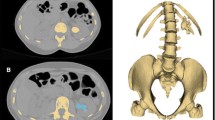Abstract
The accurate diagnosis and quantitation of nephrolithiasis in patients with primary hyperoxaluria (PH) often directly impacts the medical and surgical management for individuals with both symptomatic and asymptomatic calculi. Traditionally, depiction of the size, location and appearance of urinary calculi has been provided by kidney, ureter and bladder plain film radiographs with or without tomography. Given advances in imaging technology there is a shift from conventional radiographs to cross-sectional imaging technology, namely unenhanced computed tomography (CT), CT urography, ultrasound and magnetic resonance imaging. These diagnostic techniques provide differing advantages and disadvantages for imaging stone disease. This review outlines imaging advances in the accurate diagnosis and quantitation of patients with metabolically active stone disease such as PH.






Similar content being viewed by others
References
Diallo O, Janssens F, Hall M, Avni EF (2004) Type 1 primary hyperoxaluria in pediatric patients: renal sonographic patterns. Am J Roentgenol 183: 1767
Vrtiska TJ, Hattery RR, King BF, Charboneau JW, Smith LH, Williamson BJ et al. (1992) Role of ultrasound in medical management of patients with renal stone disease. Urol Radiol 14: 131
Fowler KA, Locken JA, Duchesne JH, Williamson MR (2002) US for detecting renal calculi with nonenhanced CT as a reference standard. Radiology 222: 109
Kawashima A, Glockner JF, King BFJ (2003) CT urography and MR urography. Radiol Clinics North Am 41: 945
Levine JA, Neitlich J, Verga M, Dalrymple N, Smith RC (1997) Ureteral calculi in patients with flank pain: correlation of plain radiography with unenhanced helical CT. Radiology 204: 27
Assi Z, Platt JF, Francis IR, Cohan RH, Korobkin M (2000) Sensitivity of CT scout radiography and abdominal radiography for revealing ureteral calculi on helical CT: implications for radiologic follow-up. Am J Roentgenol 175: 333
Smith RC, Rosenfield AT, Choe KA, Essenmacher KR, Verga M, Glickman MG et al. (1995) Acute flank pain: comparison of non-contrast-enhanced CT and intravenous urography. Radiology 194: 789
Smith RC, Verga M, Dalrymple N, McCarthy S, Rosenfield AT (1996) Acute ureteral obstruction: value of secondary signs of helical unenhanced CT. Am J Roentgenol 167: 1109
Fielding JR, Steel G, Fox LA, Heller H, Loughlin KR (1997) Spiral computerized tomography in the evaluation of acute flank pain: a replacement for excretory urography. J Urol 5: 2071
Chen MYM, Zagoria RJ (1999) Can unenhanced helical computed tomography replace excretory urography for evaluation of patients with acute urinary tract colic? J Emerg Med 17: 299
Niall O, Russell J, MacGregor R, Duncan H, Mullins J (1999) A comparison of noncontrast computerized tomography with excretory urography in the assessment of acute flank pain. J Urol 161: 534
Yilmaz S, Sindel T, Arslan G, Ozkaynak C, Karaali K, Kabaalioglu A et al. (1998) Renal colic: comparison of spiral CT, US and IVU in the detection of ureteral calculi. Eur Radiol 8: 212
Takahashi N, Kawashima A, Ernst RD, Boridy IC, Goldman SM, Benson GS et al. (1998) Ureterolithiasis: can clinical outcome be predicted with unenhanced helical CT? Radiology 208: 97
Greess H, Nomayr A, Wolf H, Baum U, Lell M, Bowing B et al. (2002) Dose reduction in CT examination of children by an attenuation-based on-line modulation of tube current (CARE Dose). Eur Radiol 12: 1571
Tack D, De Maertelaer V, Gevenois PA (2003) Dose reduction in multidetector CT using attenuation-based online tube current modulation. Am J Roentgenol 181: 331
Kalra MK, Maher MM, Kamath RS et al. (2004) Sixteen-detector row CT of abdomen and pelvis: study for optimization of z-axis modulation technique performed in 153 patients. Radiology 233: 241
Kalra MK, Maher MM, Toth TL et al. (2004) Comparison of z-axis automatic tube current modulation technology with fixed tube current CT scanning of abdomen and pelvis. Radiology 232: 347
McCollough CH, Kofler J, Zink F (2004) Hot topic: the dose consequences of new CT technology: evaluation of AEC and dose efficiency from 4 to 64-slice systems. RSNA Chicago, November 2004.
Author information
Authors and Affiliations
Corresponding author
Rights and permissions
About this article
Cite this article
Vrtiska, T.J. Quantitation of stone burden: imaging advances. Urol Res 33, 398–402 (2005). https://doi.org/10.1007/s00240-005-0490-6
Received:
Accepted:
Published:
Issue Date:
DOI: https://doi.org/10.1007/s00240-005-0490-6




